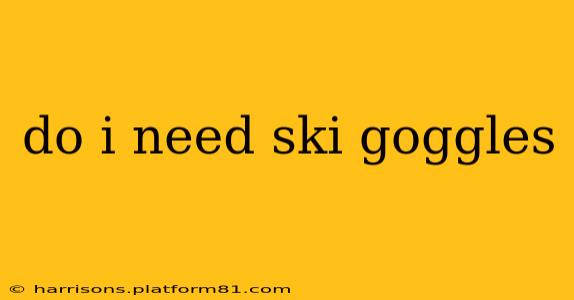Do I Need Ski Goggles? A Comprehensive Guide to Eye Protection on the Slopes
Whether you need ski goggles depends largely on the conditions and your personal preferences. While some might think they're optional, especially on milder days, ski goggles offer crucial protection and significantly enhance your skiing experience. Let's delve into the reasons why they're a worthwhile investment.
What are the benefits of wearing ski goggles?
Ski goggles provide several key benefits that extend beyond simply looking cool. They offer vital protection from the elements and enhance your vision, leading to a safer and more enjoyable day on the slopes. Key advantages include:
-
Protection from UV rays: High-altitude sun reflects intensely off the snow, exposing your eyes to harmful UV radiation. Goggles with UV protection shield your eyes from this damage, preventing long-term harm like cataracts.
-
Protection from wind and debris: The high speeds and often blustery conditions on the slopes can expose your eyes to windburn, stinging snow, and even small debris kicked up by other skiers or snowboarders. Goggles act as a barrier, protecting your eyes from irritation and potential injury.
-
Enhanced vision: Goggles improve your vision in several ways. They offer clearer vision in snowy conditions by reducing glare and improving contrast. Many goggles also feature specialized lenses designed to optimize vision in different light conditions, from bright sunshine to low-light situations.
-
Protection from impacts: While less common, the possibility of impacts exists on the slopes. Goggles provide a protective barrier against branches, snow, or even accidental collisions, reducing the risk of eye injury.
-
Comfort: Goggles protect your eyes from the drying effects of wind and cold, reducing irritation and keeping your eyes comfortable throughout your day on the slopes.
What if I wear glasses? Can I still use ski goggles?
Yes, you can absolutely use ski goggles if you wear glasses. Many ski goggles are designed to accommodate glasses worn underneath, featuring extra space within the frame. However, it's crucial to choose goggles that fit comfortably and allow for sufficient peripheral vision. Alternatively, consider goggles with prescription lenses.
Are ski goggles necessary for night skiing?
While the intense UV radiation isn't a concern during night skiing, goggles are still beneficial for several reasons. They protect your eyes from wind, snow, and flying debris, just as during daytime skiing. Also, the reduced visibility of night skiing makes it even more crucial to have clear, unobstructed vision, which goggles often provide, thanks to their anti-fogging lenses and protective design.
What are the different types of ski goggles lenses?
Choosing the right lens is essential for optimal vision and protection. Different lenses are designed to handle various light conditions:
- Clear lenses: Best for low-light or night skiing.
- Yellow lenses: Enhance contrast in overcast conditions.
- Amber lenses: Ideal for flat light or foggy conditions.
- Rose lenses: Offer good all-around visibility.
- Gray lenses: Reduce glare in bright sunlight.
Do I need ski goggles if I’m only skiing for a short time?
Even if you're only skiing for a short period, wearing goggles remains highly recommended. The intense UV radiation and potential for windburn and debris impact your eyes almost instantly. Protecting your eyes is crucial, no matter how long you're on the slopes.
In conclusion, while not strictly mandatory, ski goggles are highly recommended for the safety and comfort they provide. The benefits significantly outweigh any perceived inconvenience, making them an essential piece of equipment for any skier or snowboarder. Choosing the right goggles, factoring in lens type and fit, will ensure you maximize their protective and performance advantages.
